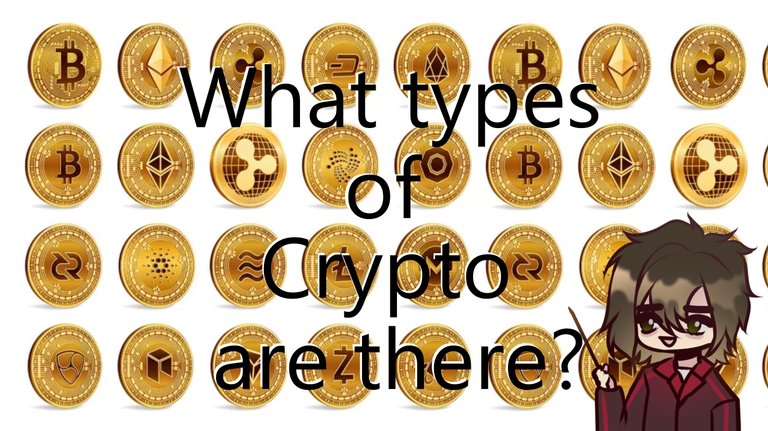All cryptos were built to fill a function. Payment, store of value, apps running on them, earning potential, borrowing, even memes are built on crypto. But there are so many broad and different use cases, I wanted to condense them into one list so it's easier to get a grasp and look into all the potential that crypto can do.

Being in one category doesn't exclude a coin/token from any other category. This is also not all the different categories of crypto there are, just the most commonly found in top 100.
1. Currency
Examples: Bitcoin, Litecoin, Bitcoin cash

These coins serve mainly as a form of transaction or store of value. You hold it and use it to pay for things you want, without the need for a middleman. Most cryptos can do this as all form of coins/tokens can be invested into or carry value.
2. Smart contract
Examples: Ethereum, Cardano, Solana

These coins can host and run smart contracts, allowing developers to build apps or new coins known as "tokens" on top of them. This allows for creation of decentralized apps and services, many tokens are built and maintained on these types of blockchains. NFTs, DEFI and Dapps are some of the functions running on these chains, you usually pay the network its native coin to be allowed to perform actions on the chain.
3. Stablecoins
Examples: Tether, USD-coin, DAI

Coins that use one of several methods to keep the coin's value pegged on a 1:1 basis to the US-dollar. Most common methods are dollar/asset backing, crypto backing or smart contract/algorithm backing. They normally adjust the value of the coin through the supply depending on market demand and thus manages to keep the value close to a dollar.
4. Wrapped/pegged tokens
Examples: Wrapped Bitcoin, Bitcoin BEP2, Bitcoin SV

Same as stablecoins, but instead they are pegged on 1:1 basis to crypto. This allows developers to make use of DEFI options for, let's say Bitcoin, without having to actually integrate the blockchain. They hold the value with similar/same methods as stablecoins, any crypto can be wrapped this way through the use of smart contracts.
5. Exchange tokens
Examples: Binance coin, Crypto.com coin, FTX token

Tokens that are created and backed by an exchange. Usually they offer perks or discounts to holders of the token. Most of these coins are also centralized.
6. DEFI tokens
Examples: AAVE, Terra, Pancakeswap

Tokens that are used on different decentralized finance applications. These protocols/platforms offer different options for investors to earn extra or passive income. Services range from allowing swap of different cryptos, adding liquidity to swaps and earning from fees or taking loans in crypto.
7. Memecoins
Examples: DOGE coin, Shiba inu token, Dogelon Mars

These coins are memes. They funny names or icons, most of these serve very little functions outside of this and is thus also often labeled as "shitcoins". The norm for these coins is actually to be tokens running on smart contract chains as that require less effort to create and maintain.
8. Privacy coins
Examples: Monero, Zcash, Decred

Different coins that maintain full anonymity and allow for transactions between addresses that can't be tracked. Most of these perform this action by making temporary addresses that receive the deposit and is then promptly deleted. Traditional blockchains don't provide full privacy despite popular belief.
9. Cross chain coins
Examples: Polkadot, Cosmos, Wanchain

Blockchains whose function is meant to allow different blockchains operate with each other. This allow applications running on one blockchain to perform actions or get data from another blockchain that is running on different nodes. These cross-chain blockchains function as a central hub and keep a consensus.
10. Layer-2 coins
Examples: Polygon, Loopring, Cartesi

Most popular as solutions running on top of Ethereum. These allow for further more advanced actions that can be performed on Ethereum. This includes more advanced smart contracts, specified features and lower fees. They have the benefit of being able to gather transactions and do them in batches and make use of a strong base layer blockchain without the negatives.
11. Game coins
Examples: Axie infinity, Decentraland, Sandbox

Dapps running on blockchain to provide entertainment. Most of these crypto serves as currencies or allow changes to be made in the app itself. This also provides a play-to-earn reward system where the crypto earned can be sold for profit.
12. Governance
Examples: AAVE, Uniswap, Pancakeswap

Tokens that give holders the opportunity to vote for changes that are proposed on the protocol or blockchain. This feature is meant to give the control and changes over a protocol over to investors and the community at large. The norm here is that the tokens held is equal to the amount of votes you have.
13. Decentralized storage
Examples: Filecoin, Arweave, Bittorrent

Blockchains built to allow users to store data and files on either the chain itself, or nodes running the chain. This system rewards nodes for providing storage while allowing users to store their data in a decentralized system. The consensus here usually functions to split up and store data across the nodes.
14. Oracle/data collection
Examples: The graph, Chainlink, UMA

Blockchains or protocols that function to gather and observe data across different blockchains. This include transactions, activity or prices. This can help developers get accurate data for building different Dapps. The service provided and the data that can be fetched varies.
15. Internet of things
Examples: Vechain, Helium, IOTA

Blockchains that work to interact with different devices and programs. This can allow devices to work together and perform various actions under a unified consensus. Data and actions that are normally confided to one device or blockchain can work together under most of these blockchains.